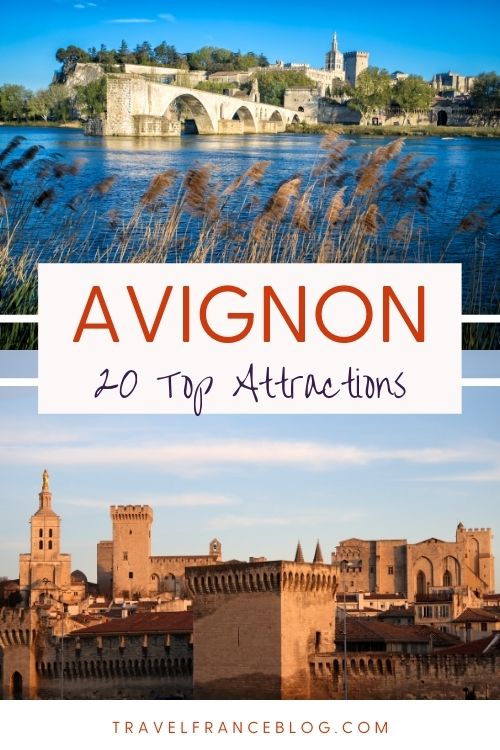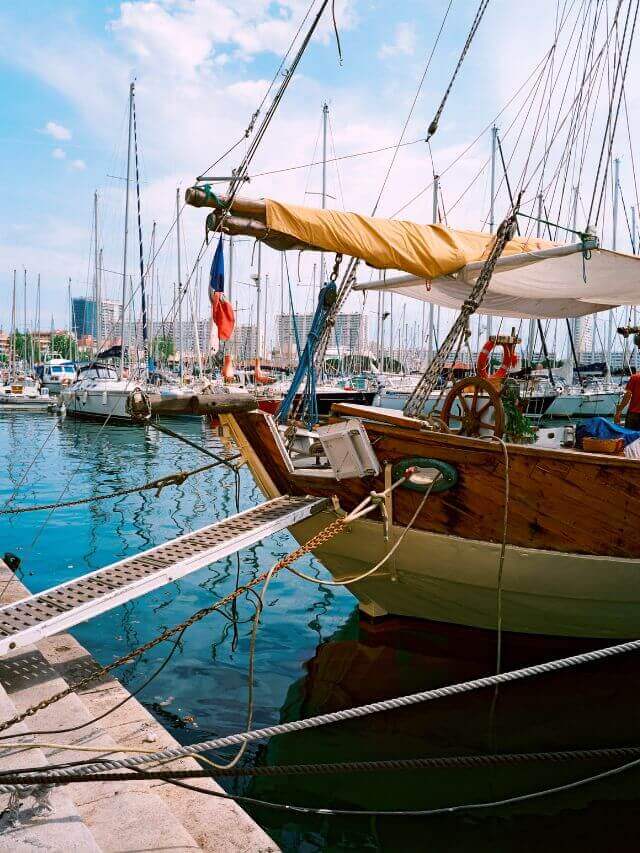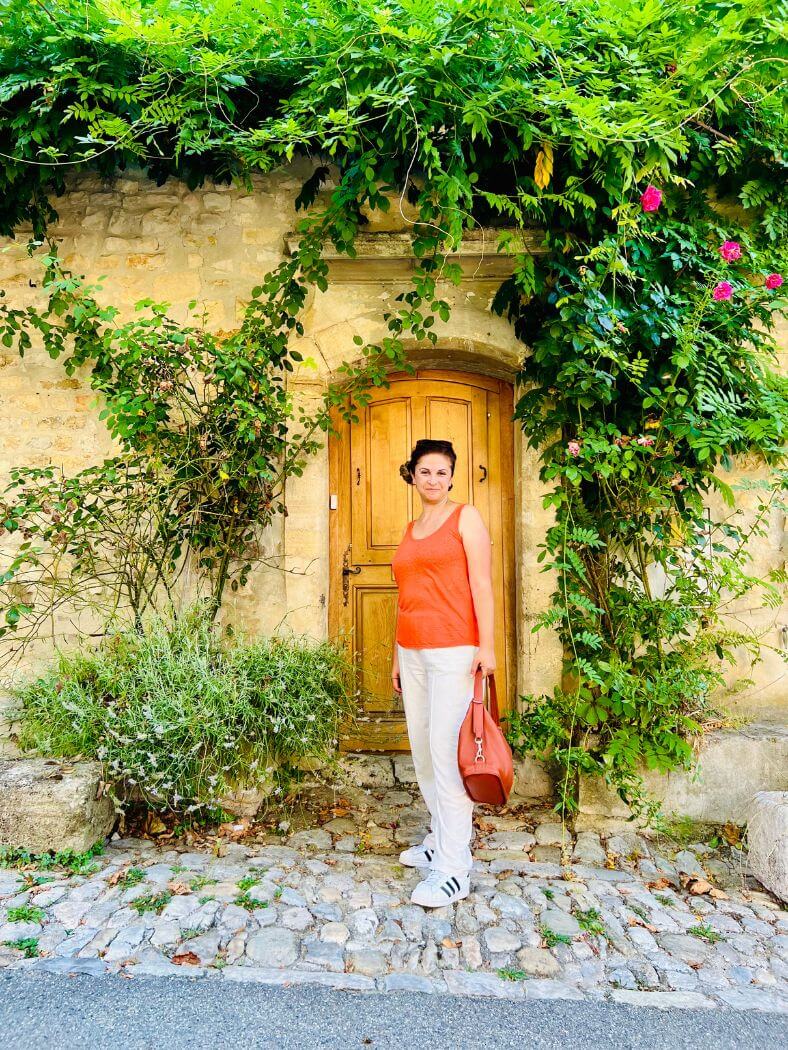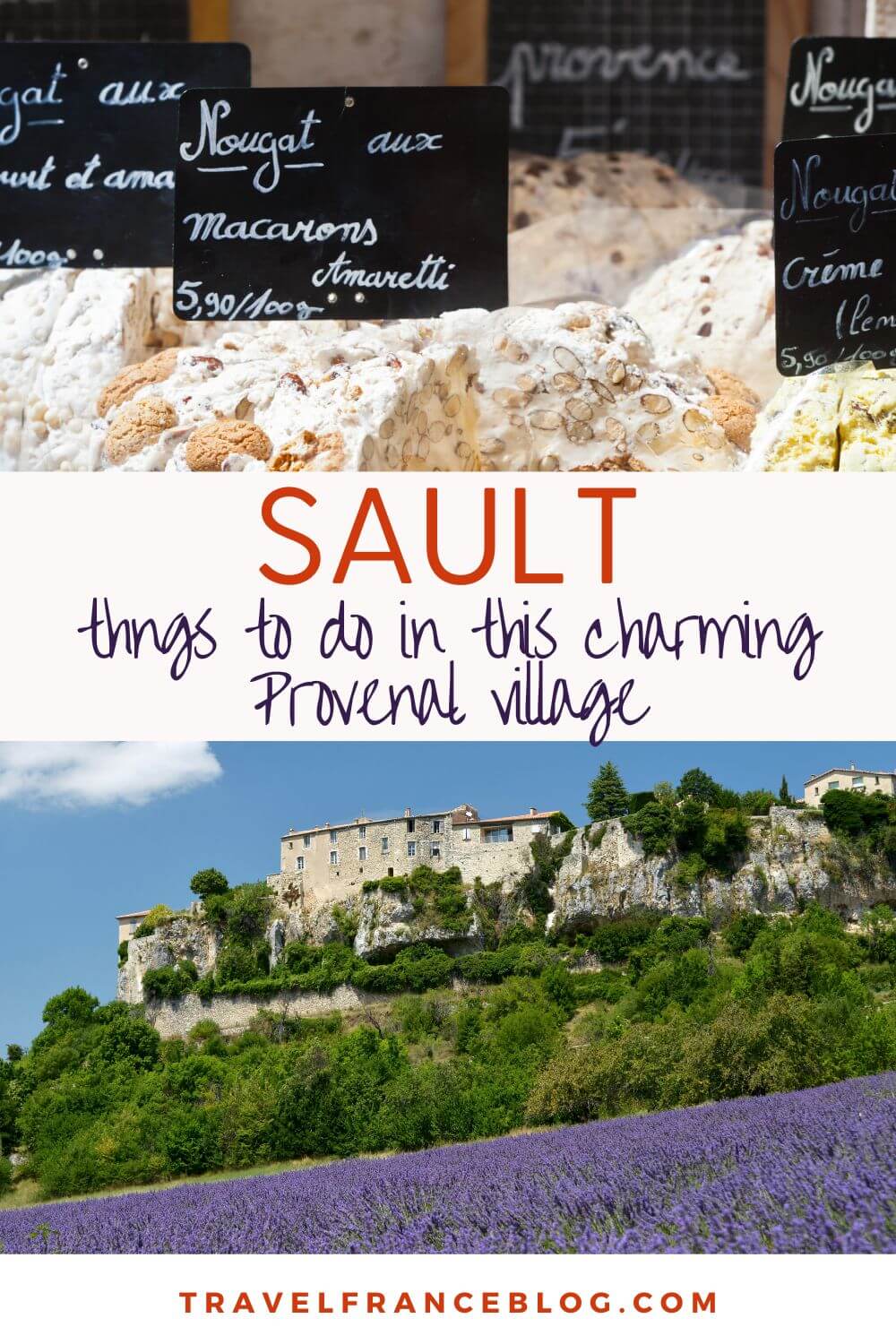Best Things to Do in Arles, France
The beautiful city of Arles is located in the southeast of France, specifically in the Region of Provence.
2000 years ago Arles was a very important city in Gaul. Close to Marseille and in the river mouth of the Rodane it was a strategic spot for commercial and military purposes.
More than 30,000 souls gave life to this city every day, it was that important, that the Romans built all the usual civil service facilities for the big cities like 2 aqueducts, Termes, Coliseum, Theater, and a Necropolis.
In its architecture, of course, you can see the tremendous Roman heritage present in this city and for which it has been declared a World Heritage Site by UNESCO.
But this city has taken as well an undisputed place in the art world in our present days.
Arles was the home and retreat of Vincent Van Gogh at the end of the XIXth century, from February 1888 to May 1889, then committed to St Remy en Provence mental hospital.
Some years later, between the fifties and seventies loved and frequently visited by Picasso, he gave huge support to the Reattu Museum and donated more than 50 designs.
Nowadays, Arles, since 1970 serves as the host of one of the most important photographic festivals in Europe, the “Rencontres d’Arles”. From July to September more than 50 photographic exhibitions, workshops and trainings turn Arles into the Capital of Photography.
In this article, I will tell you what to see and do in Arles and what are the most attractive places in this Roman city. So let’s go there!
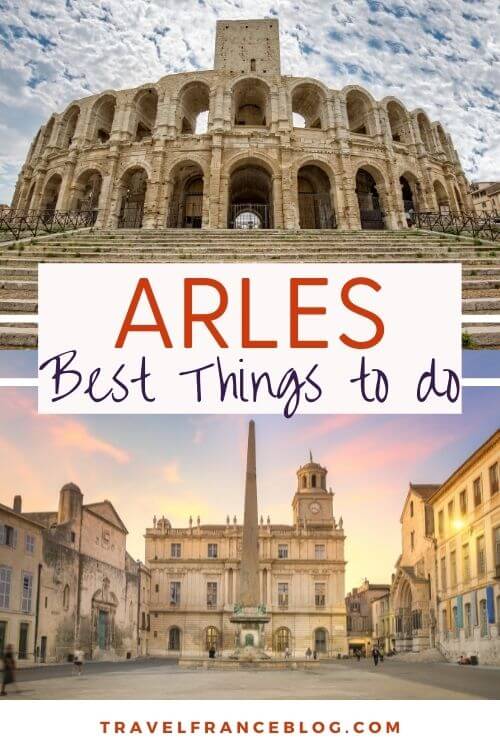
The Amphitheatre or the Arenes of Arles
The Amphitheatre is the best-known monument in the city. This Roman amphitheater was built in 80 AD and had a capacity of 21,000 people.
For more than 400 years this oval arena hosted spectacles for the Arles inhabitants.
Bare with me for a second and let’s take some perspective.
Imagine yourself 2100 years ago, life was in tribes, technology in every way was rudimentary, transportation difficult, by horse or maybe by chariot exceptionally.
And in the next turn of the street, you find this amazing building practically in the middle of the town, huge, full of people, and with the crowd chanting and shouting.
This is exactly the sensation the Romans wanted the people to have, the greatness of the Roman Empire. “Only the all-mighty Roman Empire can build this, we have to bend to the Power and be part of this”.
This is how the Romans “Romanized” the other cultures. The military campaigns were “subdue by force” and then the “Romanization by culture” arrived to finish the job.
The Amphitheater is very well preserved and continues to be the scene of different musical events and bullfighting shows.
Its architectural value and its conservation are surprising. A curious fact about this amphitheater is that despite being such an old building, it already had an evacuation plan at that time.
It’s extremely well designed for crowd control and as always in the Roman buildings there were different spaces for the different social layers. And in the process of getting in and out, there was no contact between different social classes.
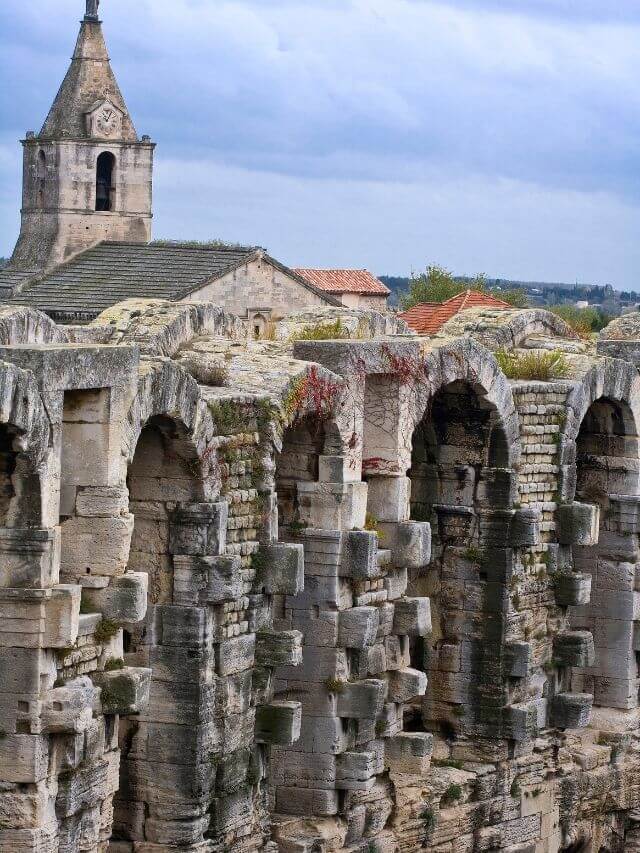
This Roman monument is a UNESCO World Heritage site and is a must-see in Arles.
In addition, you can buy your ticket for only 9 euros, but better than that, you can buy a pass for almost all the sites (6 monuments and 4 museums) in Arles for only 19 Euros on the web of Arles Tourisme.
The schedules are very changeable depending on the months in which you will visit the place, so we advise you to visit the official page of the amphitheater to find out more about the opening hours.
Related: Best things to do in Avignon
Theater of Arles
The Roman Theater of Arles is a Roman theater from the 1st century, built during the reign of Emperor Augustus.
It started around 40/30 a. C. and was completed around 12 a. C., thus becoming one of the first stone theaters in the Roman world.
Unlike the amphitheater, this monument was smaller in size and therefore had a capacity of 10,000 people.
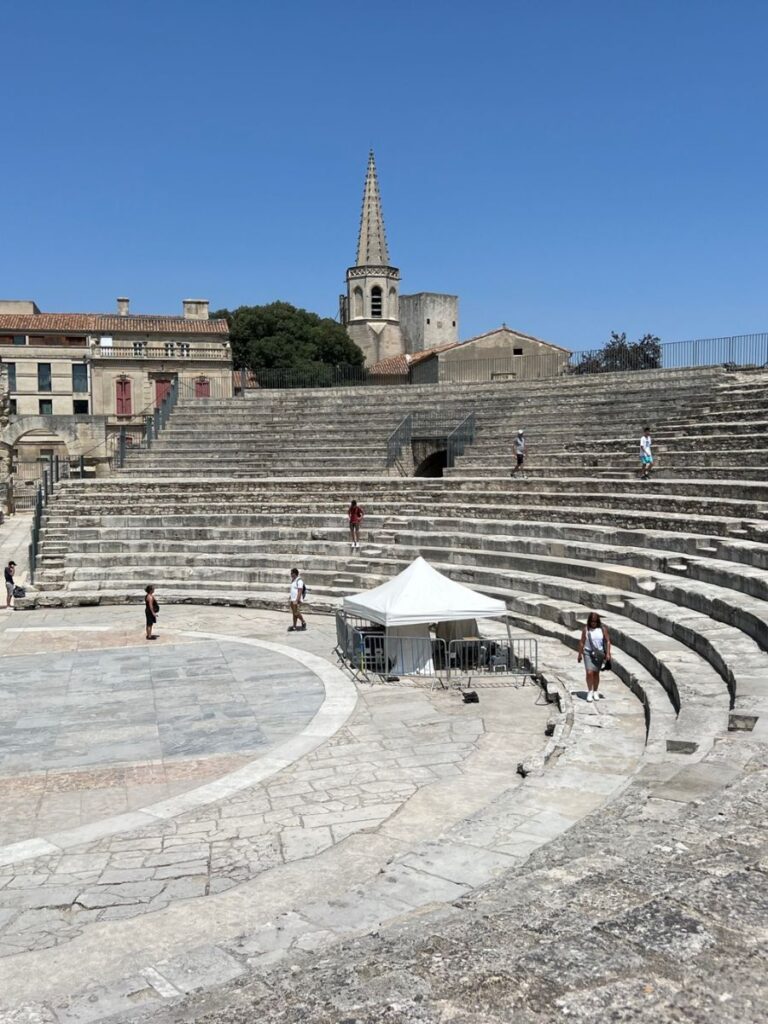
As you may already know, in ancient times, the public was distributed according to their social affiliation: the wealthiest people or part of the aristocracy were lower down while the poorest, children and women, were located at the top of the theater.
In addition, in ancient times, both women and children were not allowed to enter unless they were accompanied by an adult man.
The theater, unlike the amphitheater or the circus, offered performances that could be:
- Roman or Greek tragedies,
- comedies,
- mimes and pantomimes intended for a probably more refined audience.
Today the theater is pretty well preserved and is still a venue for performances and festivals.
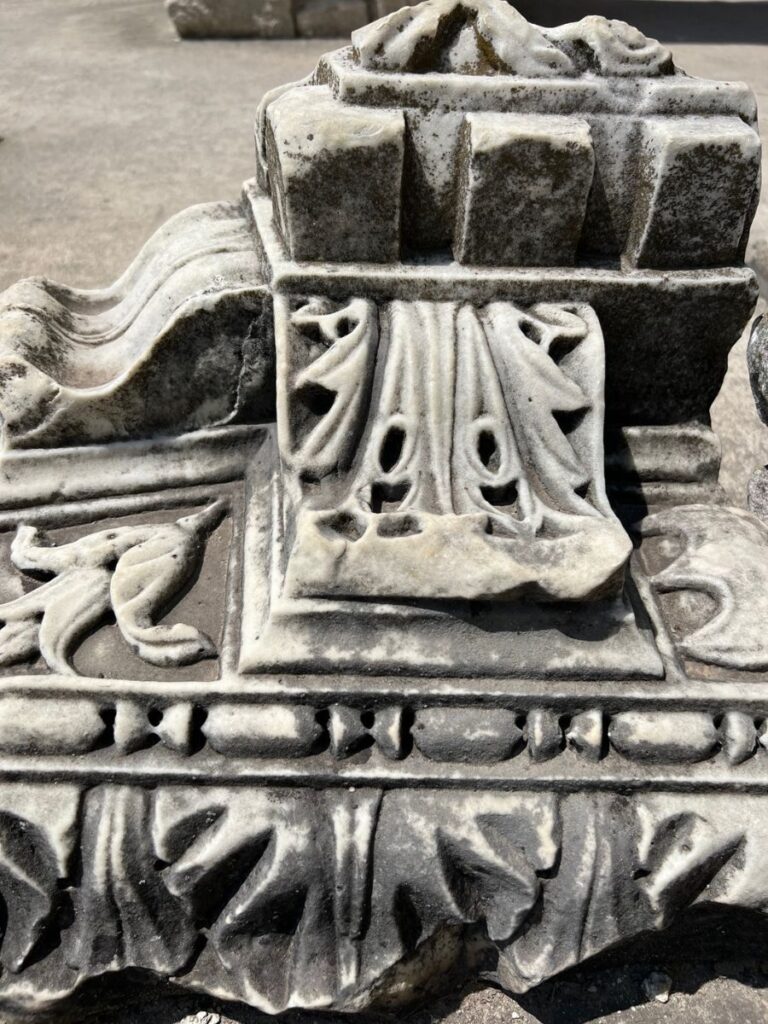
This architectural jewel of Arles hosts festivals of all kinds every year, some of which are festivals of photography, costumes, or cinema, among other arts.
Like the amphitheater, this place can also be visited by paying a ticket, or with the 6 Monuments and 4 museums pass.
A great idea is to attend an event in this place and enjoy the acoustics and the show in this Roman theater with a Greek essence.
Check out the tourist office in Arles for prices and opening times.
Museum of Arles and Provence
The Arles museum hides a great richness of the Ancient Age in its interior. This museum opened to the public in 1995 and has a large collection of objects from the Greek and Roman era found in the vicinity of Arles.
You will see busts of Roman emperors, sarcophagi, amphorae, and even Roman boats found in the Rhone River during your visit.
If you are a lover of art history, this museum has a lot to tell you about the Roman and Greek period in the South of France.
Learn about the heritage Van Gogh left in Arles
In 1888, Van Gogh arrived in Arles, and for about 15 months, Arles was the canvas of this genius.
The artist painted almost 300 paintings in this city, and we can see many of the corners of this French city in his works.
Van Gogh had come to this city after living in Paris for two years and when his mental illness began to feel more latent.
In this city, he had several ups and downs. He wrote countless letters to his brother Theo and to his friends, inviting them to come to Arles to visit him.
Only one friend took the invitation and visited him, one of his best friends and the genius Paul Gauguin.
During two months Vincent had a fantastic artistic moment sharing his art with Paul Gauguin and things went more or less fine.
Paul and Vincent worked together on some paintings, mainly about the Necropole of Arles (Alyscamps). But sometimes they had strong discussions.
The last one was really violent and Vincent was seen with a razor while Paul left hastily Arles and went back to Paris.
The next day Vincent Van Gogh was found with part of his ear cut off. After this episode, he was admitted to the hospital and was treated by doctor Felix Rey.
After this episode, he was committed to the mental health hospital of Saint Remy de Provence.
Today, Arles is still the living memory of Van Gogh, and when you visit the city, you can see his house and make a tour of all the places reflected in his paintings.
- Check Out: How to Travel France on a Budget
Church and Cloister of St. Trophime
This beautiful Church built between the XI and XII contains the remains of Saint Trophime, the first bishop of the city of Arles. Inside, the abbey stands out with beautiful capitals on its columns.
In addition, the exterior is majestic and has a cover with the 12 apostles worthy of contemplation.
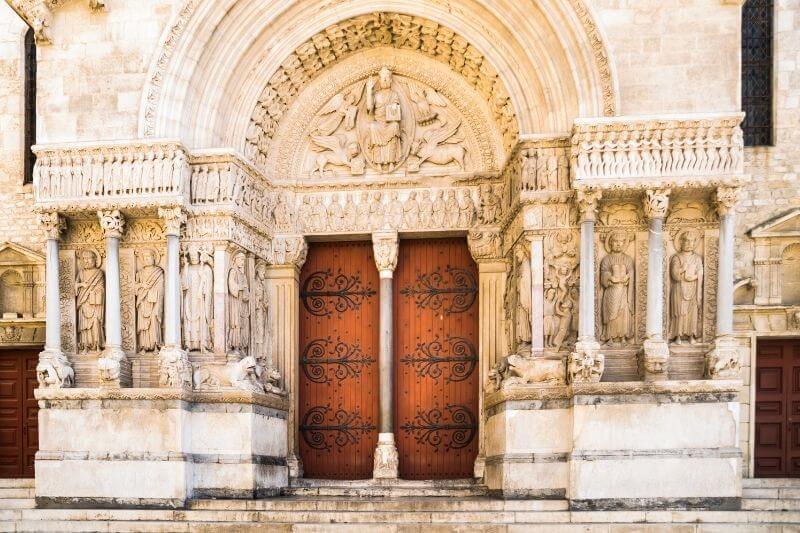
You need a ticket to visit this church; therefore we advise you buy a kind of bundle ticket to see the monuments of the historic center because it will be cheaper.
The Thermes (Baths) of Constantine
The Baths of Constantine owe their name to the emperor who had them built in the 4th century AD.
Like the Amphitheater, this is an amazing civil engineering construction that served, as we have seen, for two purposes.
The first one, placed between the city forum and the Rhône, this building was intended for the leisure and relaxation of the population of Arles, no matter the social class. And they were free.
The second one is to show the importance, power, and size of the roman empire to “romanize” the people.
The baths were heated 24/7 in the basements. There were slaves the ones in charge of keeping the fires alive.
There were countless columns made of bricks that served to sustain the floor one meter above the basement, this served as the heating chamber for the floor of the baths.
The walls had a complex network of hollow spaces like pipes inside the walls from where the hot air circulated to heat as well the walls.
The plumbing of the Roman baths was amazing.
Starting with the sourcing of the water. Contrary to what we can think, they didn’t use Rodane’s water because for the Romans this water was dirty as it received the waste and sewage of several towns and cities located upwards.
For the baths water must be pristine and clear, this is why they built two aqueducts to source water from the Alpilles mountains that are close enough.
The water canalization was designed to make the water available first priority for the fountains, secondly for the public buildings (Thermes for example), and finally for high society houses and the wealthy people.
I can’t help to be amazed at what these people did 2000 years ago.
Finally, the Thermes were not only to take a bath, but it also had restaurants, shops a library…
The Thermes were as well a refuge for the winter. If a citizen couldn’t heat his house in winter he could always go to the baths to keep himself warm.
Today, this is another of the buildings that are World Heritage Site by UNESCO and you can access and contemplate its magnificent state of conservation.
Related: Best Time to Travel To France
Montmajour Abbey
Montmajour Abbey is located on the outskirts of Arles, on the road that goes to Saint Remy de Provence.
It was built in the 10th century on a rock surrounded by marshes and was founded by Benedictine monks.
The building has been enlarged several times throughout history to become the great abbey that we can see now.
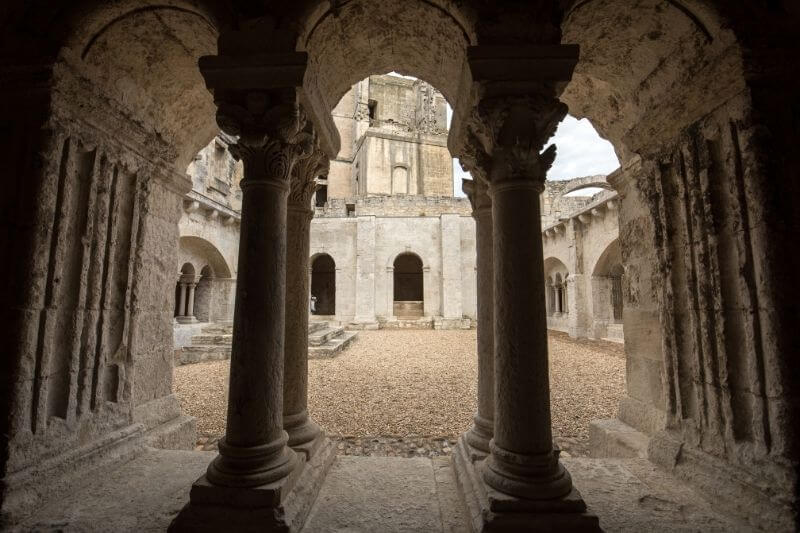
It is an unmissable place that you have to see in Arles. Here you can tour the entire interior and even the dark crypts of the temple.
If you have bought the pass for 6 buildings and 4 museums you will have a discount on the price of the ticket to the Abbey.
Alyscamps Painted by Van Gogh and Gauguin
Alyscamps is a graveyard of ancient Rome located on the city’s outskirts. In this necropolis, you can find ancient sarcophagi and a Romanesque church from the 12th century.
The popularity of this site is thanks to both painters Van Gogh and Gauguin, who, in their attempt to paint a non-naturalistic landscape, decided to capture the great avenue of tombs in a painting.
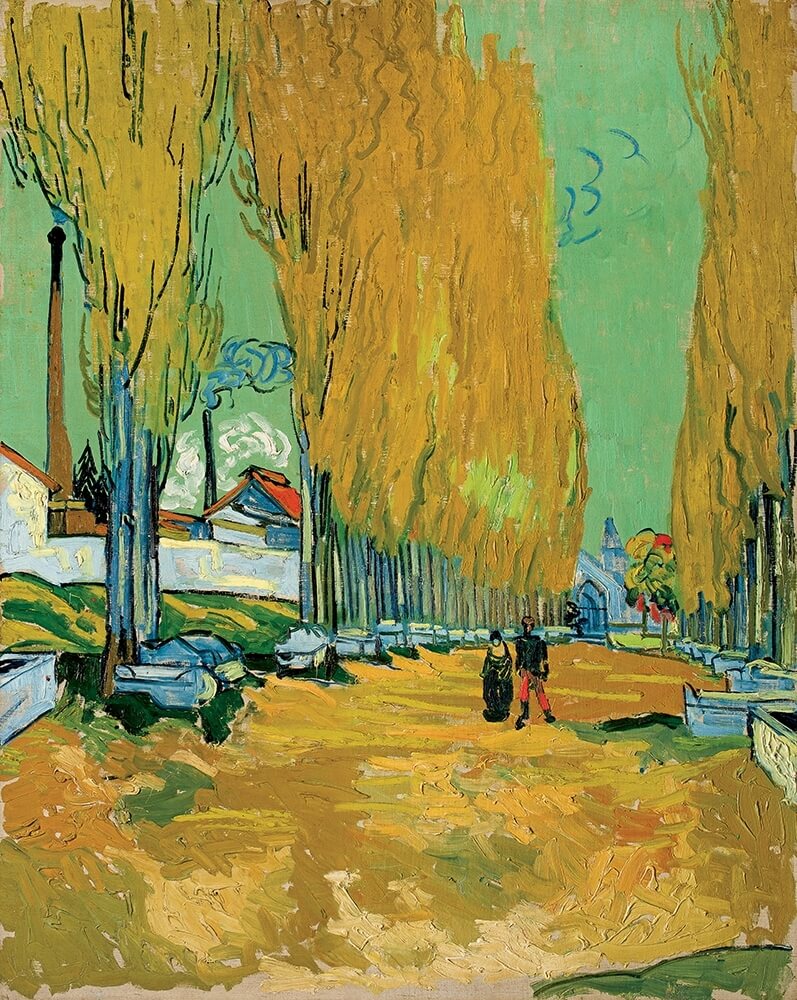
In France, this painting is known as the street of Lovers. It has become one of the most important works of the two artists.
Vincent Van Gogh Foundation in Arles
The Vincent Van Gogh Foundation of Arles was born in 2014 as a tribute to the artist who captured the corners of the city in his works.
Taking the contemporary perspective of the artist and his significant influence in this field, this foundation aims to motivate artists from all over the world to express their connection with the Dutch genius.
Here you will find works and creations by artists from all over the world who want to exhibit in this place.
The visit to the foundation costs €10.
In addition to the visit itself, this foundation has several art workshops throughout its calendar.
We recommend that you visit their website to keep an eye on the events and activities in this space and see if any coincide with the dates of your trip.
Republic Square (Place de la République)
On your walk through the center of Arles, you must stop at the Place de la République. This square is a meeting point for many visitors and locals in the area.
In the center of the square, there is a Roman obelisk from the 9th century, and in its surroundings, you will find some of the most beautiful buildings in the city, such as the town hall and the church of St. Trophime.
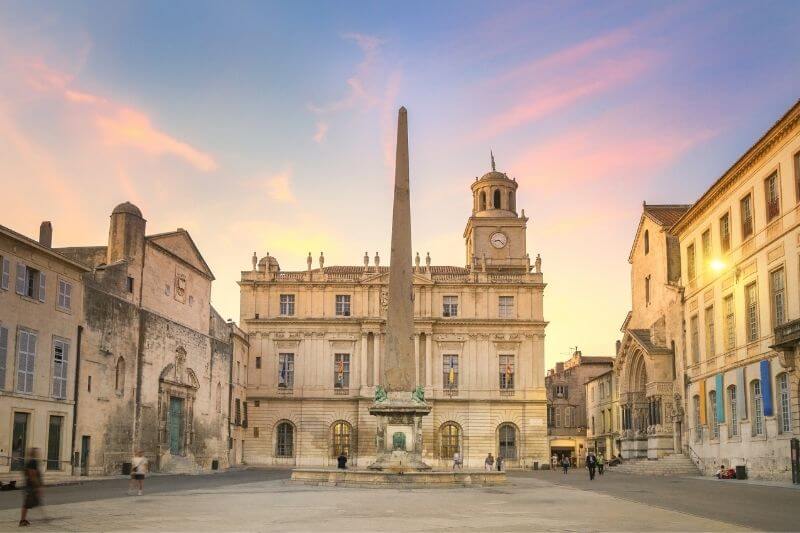
A cafe in the Place de Forum
Despite its name, it has nothing to do with the ancient Roman Forum. Instead, this square is located in the center of the city.
In it, you can find the remains of a temple dedicated to Constantine in the 1st century AD.
However, it is commonly known for the number of surrounding cafes and restaurants that make this square a place of leisure and entertainment for travelers.
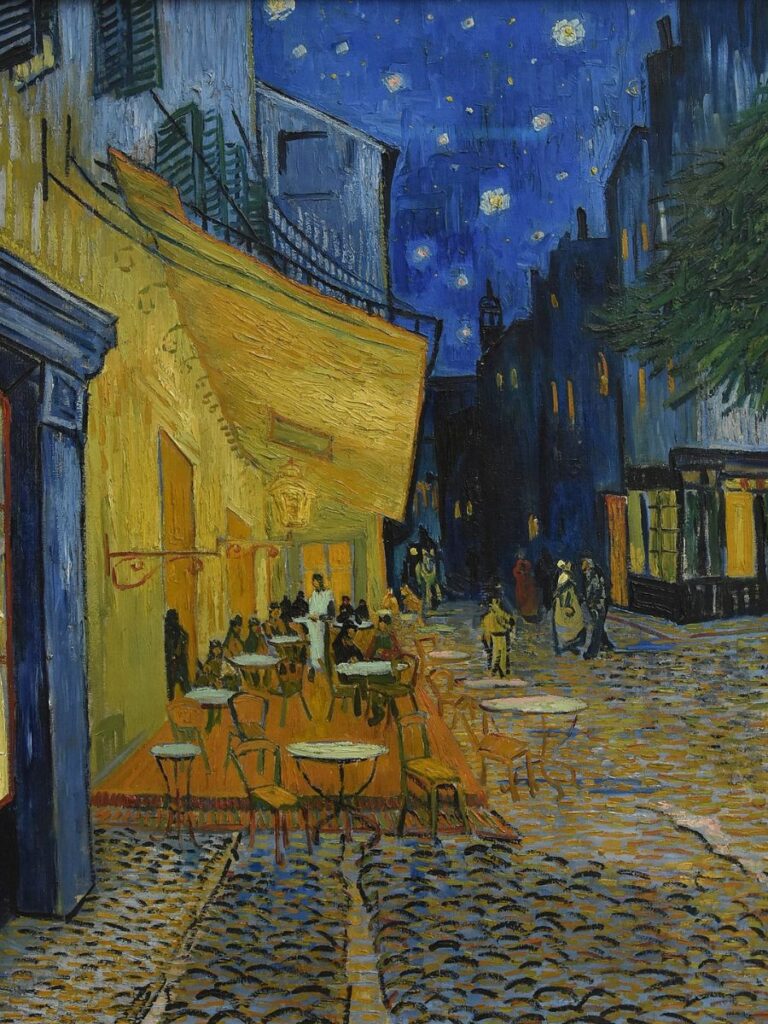
Mainly the café that Van Gogh painted. The name of the café was Café le Soir and the painting is Terrase du Cafe le Soir. Today is almost the same as the painting. You will see a lot of people taking pictures with the cafe as background.
A perfect place to rest during your visit to Arles.
Réattu Museum, for Photography Lovers
If you have an artistic mind, you might be interested in visiting the Réattu Museum.
This museum in Arles mainly collects the work of local artists, but it also has some pieces by other artists, such as Picasso from Malaga, Spain.
This museum was created in 1868 and has been restored several times. If you are a photography lover, I must tell you that they have a great collection of snapshots of great 20th-century photographers that you should not miss.
I loved this museum. They mix in the same room paintings of the 18th or 19th centuries with pictures of the 20th century. I enjoyed the contrast this gives to the museum and the exhibition is really well curated.
You will learn about the relationship that Arles has with art and photography and it will help you to understand the relationship this city has with both branches of art.
Cryptoporticus
The Cryptoporticus is one of the nicest surprises I had during my visit to Arles. The Roman heritage of Arles goes beyond the surface, and that is why we want you to know that in Arles, you can visit the city’s bowels.
First of all, let me explain why they use “cryptoporticus” as a name. My first thought was that maybe there was some information encrypted and engraved on the stone (?).
Haha, not at all, they use “Crypto” because in ancient Greek means “hidden”. It evokes the subterranean aspect of the galleries built under the porticoes of the forum square.
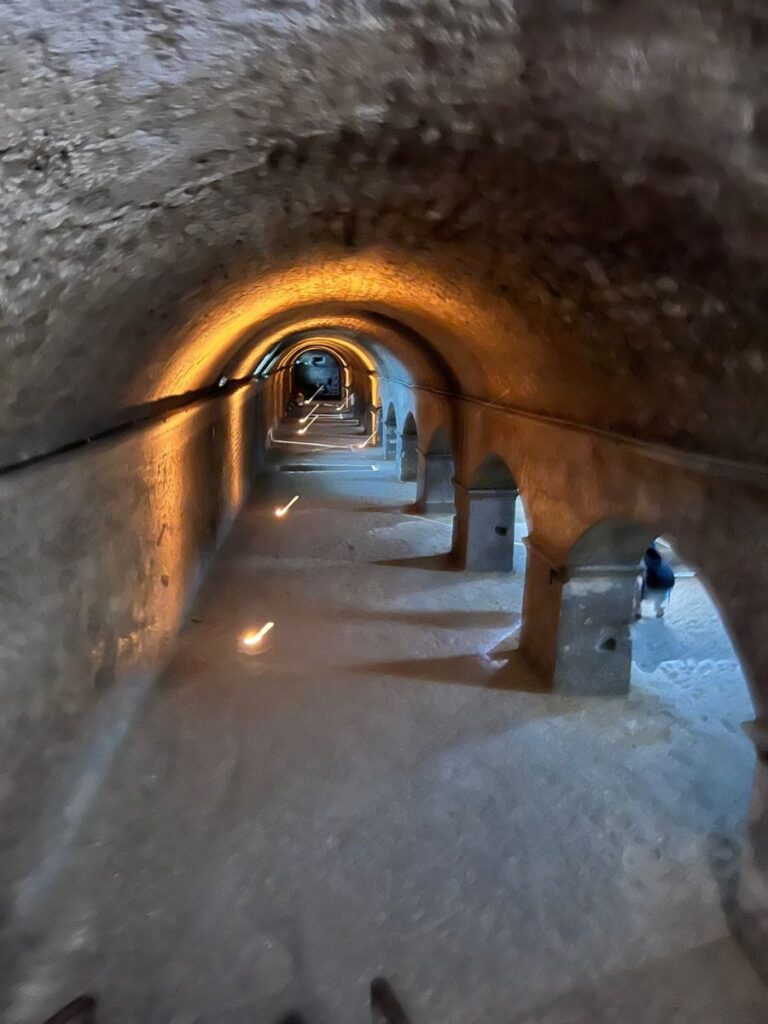
First of all, let’s understand what is the Forum. The Forum in the ancient Roman cities is the main square of the city. It was a huge square placed in the cross of the two main streets of the city.
In Arles, it was built during August’s government (25 – 10 BC) and it had 3400 square meters. It was surrounded by porticoes and its buildings were the social, economic, politic,al and religious center of the city.
Under this forum, there were solid foundations to keep the stability of the construction. And these foundations, which are galleries narrower than the porticoes above, are what you are going to visit.
They are 3 double galleries forming a “U”. Two galleries of 90 meters long and one of 60 meters long and 8.5 width.

Side to side to one of the galleries you will see as well the space kept for the shops and boutiques of the forum at that time. Probably the “Louis Vuitton” and “Christian Dior” of the Roman times given the position they were allowed to have in the forum.
You can buy your ticket to visit them and go through the different galleries. If you have bought the pass for 6 monuments, the entrance is included.
Without a doubt, a fascinating visit to the Roman city of Arles.
The Market of Arles
As the great city of Provence that it is, Arles had to have a market. The Arles market has a big day on Saturday mornings and is two kilometers long, full of scents and colors.
On Wednesday mornings, you can also go to this market, but this time in a humbler extension but equally remarkable.
Here you can find many fresh local products such as fruits, cheeses, and honey.
Chateau d’Estoublon
If you like castles, take advantage of your visit to Arles and take a day trip to visit the Chateau d’Estoublon.
This place is a historic village close to Arles, just 22 minutes by car.
Since 1489, this town has been dedicated to agriculture and is known for the great wines and oils produced in its surroundings.
Here you can discover the richness of the products of the land, the history of the place, and the people who have inhabited the old building and have a tasting of some of the best wines of Provence.
The tour costs around 60 euros and lasts approximately 1 hour and a half.
https://chateau-estoublon.com/en/
Daudet’s Moulin
Take advantage of your departure from Arles and visit the famous Daudet mill in Fontvieille, on a beautiful hill near Chateau d’Estoublon.
You can visit this windmill. Here is the Daudet Museum, in which memorabilia of the writer is exhibited.
The mechanism of the building is also explained. But, sadly and contrary to popular belief, Alphonse Daudet did not write the “Letters from my mill” here, much less live in it.
- Check Out: Les Corniches Road Trip Itinerary
Barbegal Aqueduct
In Roman cities, water reached the cities through aqueducts, and in Arles, you can still find remains of this engineering work that supplied the population in Roman times.
The ruins of this aqueduct are located about 12 km from the city, and it was the architect of moving a vast flour mill from the area that produced flour for the region.
In those times, this aqueduct was one of the most important in the entire Roman Empire.
Camargue National Park
If you stay in Arles for a few days, we recommend that you use one of them to visit this beautiful Natural Park that is only 14 minutes by car toward the coast.
In this natural area, you can enjoy a wonderful walk through semi-fenced land where you can see various species in semi-freedom, such as horses, bulls, and turtles.
The landscape itself is a gift that Provence gives us, decorated with its lagoons and its birds fluttering around this place. If you are lucky, you may even see flamingos in the area.
We hope that this guide to Arles will help you organize your trip to this Roman city in the south of France and that you will make the most of your visit to the Pearl of Provence.

Plan your trip to Provence and the South of France
- Driving in the South of France
- Lavender fields in Provence
- The different seasons of the year in France
- What to see in Avignon
- Visit the Calanques National Park
- What to see in Aix-en-Provence
- What to visit in Antibes
- How to save money while traveling in France
This post may include affiliate links. This means that we will receive a small fee if you make a purchase through our links. It has no additional cost to you. It’s a win-win!
